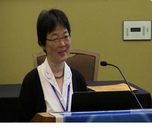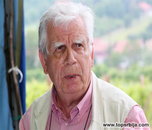Day 1 :
Keynote Forum
Grace Chen
U.S. Department of Agriculture
Keynote: Biotechnology for Improved Hydroxy Fatty Acid Production in Oilseed Lesquerella
Time : 09:15-10:00

Biography:
Present works in U.S. Department of Agriculture, Western Regional Research Center, Agricultural Research Service
Abstract:
The conventional source of hydroxy fatty acid (HFA) is from castor (Ricinus communis), 90% of castor oil is ricinoleic acid (18:1OH). Ricinoleic acid and its derivatives are used as raw materials for numerous industrial products, such as lubricants, plasticizers and surfactants. The production of castor oil, however, is hampered by the presence of the toxin ricin and hyper-allergic 2S albumins in its seed. Lesquerella (Physaria fendleri), being developed as a new industrial oilseed crop in the southwestern region of the United States, is valued for its HFA, lesquerolic acid (20:1OH), in seed. As lesquerella does not contain toxic compounds, its oil represents a safe source of HFA. To understand HFA synthesis and regulation in lesquerella, we investigated morphological and physiological changes, as well as temporal details of fatty acid composition and gene expression during seed development. Also we have developed the 1st lesquerella seed transcriptome that provides a global gene expression profile for identifying key targets for metabolic engineering in lesquerella. We found that the synthesis of 20:1OH is regulated largely by gene expression of PfKCS3. By suppressing the expression of PfKCS3 in leaquerella, 18:1OH was increased from wild-type (wt) 1% to 26% in transgenic seed oil. Castor oil has 90% 18:1OH which occupies all three sn positions of most TAGs, while lesquerella oil contains 60% 20:1OH mostly located at sn-1 and sn-3 of TAGs. In order to improve HFA levels in lesquerella seeds, a castor lysophosphatidic acid acyltransferase 2 gene (RcLPAT2) capable of acylating HFA to the sn-2 position of TAGs was introduced into lesquerella. Analysis of transgenic lesquerella seed TAGs showed that RcLPAT2 was able to incorporate HFA to the sn-2 position of TAG and consequently, oil accumulated more of TAGs with all three sn positions occupied by HFA. The results enhanced our understanding of plant lipid metabolism and provided invaluable guidance for future research not only for enhancing HFA content in lesquerella, but also for HFA production in other oilseed crops.
Keynote Forum
Dragan Škorić
Professor University of Novi Sad Serbia
Keynote: ACHIEVEMENTS AND FURTHER DIRECTIONS IN SUNFLOWER BREEDING IN THE WORLD
Time : 10.00-10.45

Biography:
Faculty of Agriculture of the University of Novi Sad. Honorary Member for International Sunflower Association.
Abstract:
Global sunflower breeding can be divided into two periods. The first one, spanning 1910 to 1970, was when the Russian Empire and the USSR developed productive varieties with a high seed oil content, resistance to the dominant diseases, the sunflower moth, the broomrape races of the time, and broad adaptability. Also, during the same period, varieties were developed in Argentina that were suitable for the conditions of South America. The second period, from 1970 until the present, was marked by the discovery of sources of cytoplasmic male sterility and the restorer genes, which has enabled the use of the phenomenon of heterosis and the development of sunflower hybrids. This period is characterized by the establishment of important breeding programs in public institutions and private companies. The result of their work is the development of a large number of productive hybrids, which have helped the increase of the acreage in sunflower on a global scale and the increase of yields and their stability.Of all the field crops, the sunflower has the largest number of wild relatives within the genus Helianthus. There are diploid, tetraploid, and hexaploid wild sunflower species. Among them, the perennial species are more common than the annual ones. Using interspecific hybridization, a number of desirable traits have been incorporated into cultivated sunflower genotypes from the wild species. Especially of note is the contribution of the wild species to sunflower breeding for resistance to biotic and abiotic stresses. An important place in sunflower breeding belongs to spontaneous and induced mutations, the contribution of which has been manifested the most in the change of oil quality (fatty acids and tocopherols). High-oleic hybrids have been developed, as have been the hybrids with different types and levels of tocopherols (alpha, beta, gamma, and delta).
- Plant Genomics| Plant Breeding | Plant Science | Plant Biotechnology | Plant Genomics Applications | Plant Genome Sequencing
Location: 1

Chair
Kirankumar S. Mysore
Professor The Samuel Roberts Noble Foundation USA

Co-Chair
Arron H Carter
Washington State University, USA
Session Introduction
Joohyun Lee
University of Massachusetts Amherst, USA
Title: Upstream regulatory mechanisms of a cold-induced epigenetic switch in plants
Time : 11:05-11:35

Biography:
Joohyun Lee Present works as a Research Assistant Professor Biology Department, University of Massachusetts Amherst
Abstract:
Proper timing of the flowering transition in plants is a key developmental process necessary for adaptation to various ecological niches. Many plant species require exposure to the prolonged cold of winter to flower, a temperature-sensing process referred to as vernalization. In Arabidopsis thaliana, prolonged exposure to cold epigenetically represses the expression of a floral repressor, FLOWERING LOCUS C (FLC). This cold-mediated repression occurs through an evolutionarily conserved Polycomb repressive complex 2 (PRC2) associated with the vernalization-unique protein VERNALIZATION INSENSITIVE 3 (VIN3) and long noncoding RNAs (lncRNAs) complementary to FLC. The vernalization-specific PRC2 complex results in increased deposition of an epigenetic silencing mark H3K27me3 at FLC chromatin. However, the system by which cold perception leads to the induction of vernalization-specific factors involved in FLC targeting is largely unknown. In this study, we describe the first example of a vernalization-hypersensitive mutant in which the period of cold exposure required to saturate the vernalization response is shortened. This is also the first example of a potential upstream regulator of VIN3 and lncRNAs complementary to FLC. The causative locus encodes a methyltransferase, SET DOMAIN GROUP7 (SDG7), that is required for proper timing of expression of vernalization specific factors in cold-induced polycomb silencing (1). In summary, our work is an important contribution to the understanding of how environmental signals result in epigenetic gene silencing.
Raquel Sánchez-Pérez
University of Copenhagen , Denmark
Title: Transcriptomics towards flowering in fruit trees
Time : 11:35-12:05

Biography:
Raquel Sánchez Pérez´s research topic is the study of important agronomic traits within Prunus species, with a desired practical output both for food production and farmer economy. Her research is focused on flowering time and the origin of bitterness in sweet cherry and almond, respectively. The final aim is to develop molecular markers for application in breeding programs that will help to obtain new improved cultivars that are more resistant to the negative effects of climate change. In the last years, she has supervised three PhD theses on secondary metabolites, i.e. cyanogenic glucosides, in flower bud dormancy, seed germination and fruit development. She is further teaching Biochemistry at Copenhagen University, where she is employed and funded by the Villum Foundation, under the Young Investigator Program
Abstract:
Statement of the Problem: Global warming is threatening the production of more than 40 million tons of stone fruit from the Prunus genus (e.g. cherry, almond, apricot, peach, etc.). The main reason for this is the decrease in the winter chill which is necessary for the flowering process. Hence, the ability to control dormancy release and flowering in perennial plants is extremely desirable.In the past, different cyanide-based products e.g. hydrogen cyanamide (Dormex®, AlzChem, Germany) have been used in agriculture to compensate for missing winter chill and to advance flowering, suggesting cyanide as a key player in dormancy release. Interestingly, cyanogenic glucosides, which constitute one component in an ancient plant defense system, are also known to release cyanide. The cyanogenic glucoside prunasin is present in flower buds of Prunus plants. Cyanide-based inhibition of antioxidant enzymes like catalase leads to increasing ROS levels, which are known to be important messengers in various cellular processes, like seed germination, a process related to bud dormancy release. Therefore, the purpose of this study is to show how Dormex® is advancing flowering time in fruit tree species like cherry.Methodology: Dormant sweet cherry flower buds were treated with Dormex® and water as a control, sampling flower buds at different time points up to 18 days after treatment. The effects of Dormex® were assessed using RNA sequencing, metabolite profiling and enzyme assays.
Weerachai Phutdhawong
Kasetsart University, Thailand
Title: Synthesis and preliminary evaluation of brassinosteroid derivatives for plant growth regulators
Time : 12:05-12:35

Biography:
Weerachai Phutdhawong is an Associate Professor of Organic Chem. at Kasetsart University at Kamphaengsaen, Thailand. He obtained BS from Prince of Songkla University, Thailand and MS and PhD from Chiang Mai University in Thailand and Post-doc (Natural Products Chemistry) at NIES in Japan. His research interest has two main intersecting themes. The first involves the development of methods for the synthesis of novel bioactive compounds and the study of their spectroscopic, chemical and pharmacological properties. Mechanistic aspects of these and associated syntheses are also of interest. New synthetic methods for antibiotic compounds are also being investigated.
Abstract:
Brassinosteroid (BRs) are unusual steroids with a lactone B-ring structure and a dihydroxylate side chain. These steroids have been isolated from many plant species and have been recognized as hormones potentially affecting a wide range of physiological responses in plants, including stem elongation, pollen tube growth, leaf bending and epinasty, root growth inhibition, induced synthesis of ethylene, activation of proton pump, xylem differentiation, synthesis of nucleic acids and proteins, activation of enzymes, and photosynthesis. The brassinolide a C28 brassinosteroid has been reported to be the most biologically active of the BRs and widely studied for applications due to their potential agricultural utility. 28-Homobrassinolide and 28-homocastasterone, the most active C29 BRs have also been intensively investigated for their potential agricultural uses. As BRs are present in plants only in very small quantities, chemical synthesis of BRs is the source for scientific and practical use. This results in numerous synthetic efforts and development of non-natural analogues of BRs that are easier to prepare and which have similar or even greater activity than the natural BRs. In this article, the 28-homocastasterone (3), and analogues including their dimeric compounds were prepared from stigmasterol via a key intermediate olefin. Evaluation of the rice lamina inclination bioassay of the synthesized compounds showed they have lower bioactivity than 28-homocastasterone. However, the novel molecules can be further investigated for other properties, such as persistence, and the results give design considerations for molecules with structures recognized by brassinosteroid receptors.
Fahimeh Shahinnia
IPK, Germany
Title: Improvement of biomass and stress tolerance in crop plants using cyanobacteria flavodi-iron proteins (FDPs)
Time : 13:35-14:05

Biography:
engineering the strategies aimed at improving stress tolerance in barley with emphasizing on genome-editing and overexpression of plant-endogenous genes belonging to different molecular networks for stress responses. Her research interests are: cereal structural and comparative genomics, map-based cloning, QTL mapping, marker assisted breeding, genetics and genomics of drought tolerance, genome-editing and systems biology in barley and wheat..
Abstract:
Environmental stresses and nutrient limitation are among the major causes for crop losses worldwide. Engineering strategies aimed at improving growth and stress tolerance have mostly focused on overexpression of plant-endogenous genes belonging to molecular networks for stress perception or stress responses. A new alternative approach has recently been applied with considerable success to model plants. It is based on the replacement of stress-sensitive plant targets such as ferredoxin by stress-resistant cyanobacterial flavodoxin. The expression of cyanobacterial flavodoxin in chloroplasts in transgenic tobacco plants led to tolerance to various stresses including drought and iron starvation, thus representing a biotechnological application for the generation of crops tolerant to multiple stresses. In the present study, we have tested additional cyanobacterial proteins, flavodi-iron proteins (FDPs), for further investigation of this approach. FDPs are widely distributed among bacteria, archaea and cyanobacteria and show various properties such as dioxygen-scavenging reductase and nitric oxide-scavenging reductase activity indicating a response to oxidative stress superior to that of flavodoxin. In Cyanobacteria, FDPs are encoded by four different genes Flv1, Flv2, Flv3 and Flv4 and function in tandem. Further, FDPs are a sub-class of redox-active proteins containing Fe in a form that does not occur in higher plant proteins. We have introduced the Flv genes in the genome of the plant species Arabidopsis, tobacco and barley to identify the underlying molecular and biochemical mechanisms for their protective action against oxidative stress and to identify the environmental and nutrient conditions, under which Flv-mediated stress tolerance allows for biomass and yield enhancement.
Rachel Swee-Suak Ko
Academia Sinica, Agricultural Biotechnology Research, Taiwan
Title: Manipulation of a bHLH transcription factor to generate male sterility line in rice
Time : 14:05-14:35

Biography:
Rachel SS Ko devotes herself in functional genomics studies in rice and orchid. She identified a key bHLH transcription factor in rice that is essential in rice pollen development. She is interested to carry out detail study on the molecular mechanism underlying pollen development to improve agriculture application of male sterility line for hybrid rice yield improvement.
Abstract:
Hybrid rice is a promising strategy to increase grain yield by 15-20%. Stable male sterility line is important for pure F1 hybrid seed production. We identified a male-sterile TRIM mutant without pollen development in rice. Southern blot indicated that this mutant is single T-DNA insertion even. Heterozygous mutant is fertile and homozygous line is male sterile. Our genetic analyses confirmed that the male sterility in this mutant is controlled by a single recessive locus. Knockout mutant cannot enter meiosis, defects in tapetal programmed cell death and hypertrophy tapetal cells, consequently lead to no pollen development. To know more about the molecular function of bHLH142, we overexpressed bHLH142. Surprisingly, OE lines also showed male sterility. OE caused premature onset of tapetal PCD, defective in ROS scavenging in the anther. Altered expression of several key regulatory transcription factors such as UDT1, GAMYB, TDR1, and EAT1 were found upregulated in OE anther. Our detail molecular study demonstrated that bHLH142 and TDR1 form protein-protein interaction and co-modulate transactivation of EAT1. Either knockout or OE of bHLH142 both lead to defect or premature PCD, eventually all turn out to be sterile. Indicating that homeostatic and tightly control of bHLH142 expression is essential for normal pollen development. This study provides a new method to generate genic male sterility in rice and possibly in other cereal crops too. Moreover, exploitation of this novel functionality of bHLH142 would confer a big advantage to hybrid seed production
Raj Kumar Joshi
Siksha O Anusandhan University, India.
Title: Non-coding RNAs: the master regulators of immunity against phytopathogens
Time : 14:35-15:05

Biography:
Raj Kumar Joshi is Assistant Professor at the Centre of Biotechnology, Siksha O Anusandhan University, India where he teaches graduate level courses on Plant Genomics and Genetic engineering. He also serves as Group Leader of the Centre’s Plant Functional Genomics Group, and in that capacity he supervises the overall research activities on the functional aspects of non-coding RNAs during plant-microbe interactions. He has initiated a collaborative research with Prof. Nat Kav from University of Alberta, Canada to explore the functional role of long non coding RNAs in the anti-fungal networks of B. napus. Dr. Joshi is a life member of the Society of Plant Biochemistry/Biotechnology and the Association of Biological Chemists in India
Abstract:
The whole genome tilling and RNA-Seq analysis has revealed that pervasive transcription is a widespread feature of all eukaryotic genomes. Recent evidences indicate that a significant portion of this unannotated transcripts called the ‘dark matter’ are actually non-coding RNAs with important role in a wide range of biological processes. However, the repertoire and functions of ncRNAs (microRNAs and long non-coding RNAs) largely remains unexplored with respect to defense against phytopathogens. To investigate their role in disease resistance, we have used next generation sequencing approaches to identify ncRNAs responsive to necrotrophic fungi in multiple plant-microbe interactions. A stranded RNA-Seq has resulted in 3181 lncRNAs responsive to Sclerotinia sclerotiorum infection in Brassica napus. A reciprocal expression pattern of the sense/antisense transcript pairs suggested steric clashes of transcriptional machinery and lncRNA mediated inactivation of sense promoter during pathogen attack. Functional characterization of these lncRNAs using RNAi knock-down lines demonstrated their possible role in immunity of canola against Sclerotinia sclerotiorum. Another study on small RNA-seq analysis has resulted in forty-six microRNAs responsive to Fusarium basal rot infection in Allium sativum. Overexpression of a selective set of miRNAs in transgenic garlic plants revealed enhanced resistance to FOC through up-regulated expression of defense-responsive genes and decreased fungal growth. These results indicate that multiple ncRNAs are involved in plant immunity and are critical elements in the defense network of plants against pathogenic fungi
Clive Lo
Associate Professor at The University of Hong Kong
Title: Distinct biosynthesis pathways for flavone C-glycosides and O-glycosides in rice
Time : 15:25-16:00

Biography:
Clive Lo received his PhD at Purdue University. He is currently an Associate Professor at The University of Hong Kong. His laboratory has been working on the biosynthesis pathways of flavonoids in the cereal crops rice and sorghum. They have recently identified a number of phylogenetically conserved enzymes for biosynthesis of flavones which are prevalent in vegetative tissues of grasses. They represent good targets to engineer flavones in edible tissues which do not normally synthesize these health-beneficial phytochemicals
Abstract:
Flavones are flavonoids found extensively in land plants with important physiological functions like UV protection, interactions with other organisms, co-pigmentation in flowers, etc. They are increasingly popular as dietary constituents or supplements due to their health-beneficial properties. In grasses, flavones are predominantly accumulated as C- or O-linked conjugates in vegetative tissues. The enzymology of flavone biosynthesis in monocot remained largely elusive until recent years. Our recent work established the cytochrome P450 enzymes CYP93G1 and CYP93G2 as key branch point enzymes in rice channeling flavanones to the formation of flavone O-linked conjugates and C-glycosides, respectively. CYP93G1 functions as a flavone synthase II, which generates flavone aglycones for different O-linked modifications. On the other hand, CYP93G2 is a flavanone 2-hydroxylase, which produces 2-hydroxyflavanones for immediate C-glycosylation, followed by the formation of the flavone nucleus. We further filled the remaining gap in the tricin biosynthesis pathway with CYP75B4. In tricin, the 3’, 5’-dimethoxyflavone nucleus is formed before O-linked conjugations. CYP75B4 functions as a unique flavonoid 5’-hydroxylase that converts chrysoeriol to selgin, the immediate precursor of tricin. In addition, transgenic expression of CYP93G2 and CYP75B4 in Arabidopsis resulted in accumulation of different tricin O-glycosides which are not normally present in the mustard family. CYP93G1, CYP93G2, and CYP75B4 homologous sequences are unique but highly conserved in Poaceae, suggesting that they are specifically recruited for the biosynthesis of different flavone-derived metabolites that are prevalent in many grass species today.
Chee-Keng Teh
Sime Plantation R&D Centre, Malaysia
Title: The path from genomic discovery to commercial planting in oil palm
Time : 16:00-16:30

Biography:
Chee-Keng Teh holds a position of Chief Molecular Breeder II in Biotechnology and Breeding Department, Sime Darby Plantation R&D Centre. He has his expertise in quantitative genetics, development genetic tools and prediction models to maximize genetic gains in oil palm breeding. He and a team of multidisciplinary scientists in Sime Darby Plantation started genomic discovery programs since 2009, and has successfully realized transition from the discoveries to commercial planting in 2016. Before 8 years of humble service in Sime Darby Plantation, he completed 2-year MSc program in National University of Malaysia based on his research on genetic diversity of oil palm germplasm supported by Malaysia Palm Oil Board (MPOB). Currently, he is pursuing his PhD degree in University of Nottingham
Abstract:
Statement of the Problem: The objective of oil palm breeding is to produce high-yielding materials. In Southeast Asia, thick-shelled Deli dura (D) and shell-less AVROS pisifera (P) are maintained separately as maternal and paternal pools, respectively. The reciprocal recurrent selection (RRS) of elite parents is based on the performance of thin- shelled tenera progeny derived from DxP crosses. However, large- scale DxP crossing to evaluate every individual of D and P is impossible due to resource constrains. Furthermore, RRS required more than 20 years completing a selection cycle. The snail’s-pace breeding will put the oil palm industry at risk, when the planting materials fail to cope with drastic changes in the environment. The paper will cover the experience of developing genetic tools and prediction models for early selective breeding. The challenges of translating the genomic discoveries to commercial deployment also will be discussed.
Methodology & Theoretical Orientation: Sime Darby Plantation sequenced the oil palm genome in 2009. A 200K-SNP array, OP200K was then developed after quality filters. The array was used for genome-wide association study (GWAS) and followed by genomic selection (GS) to further improve prediction accuracy. To facilitate commercial deployment, a high-throughput pipeline was also developed in house.
Findings: About 6 million SNPs were identified throughout the genome, representing important breeding stocks in the industry. Important QTLs for bunch component and oil yield traits were successfully detected. The QTL profile was used as the basics for GS modeling, which achieved >0.5 of prediction accuracy.
Conclusion & Significance: The density-reduced SNP panel with minimal accuracy trade-off is now available for selecting the best yielding seeds in Sime Darby Plantation. The first 100 ha planting of Genome Select seeds with estimated 16% of yield increment were launched in April 2016. The upscaling of Genome Select seed production is currently taking place
